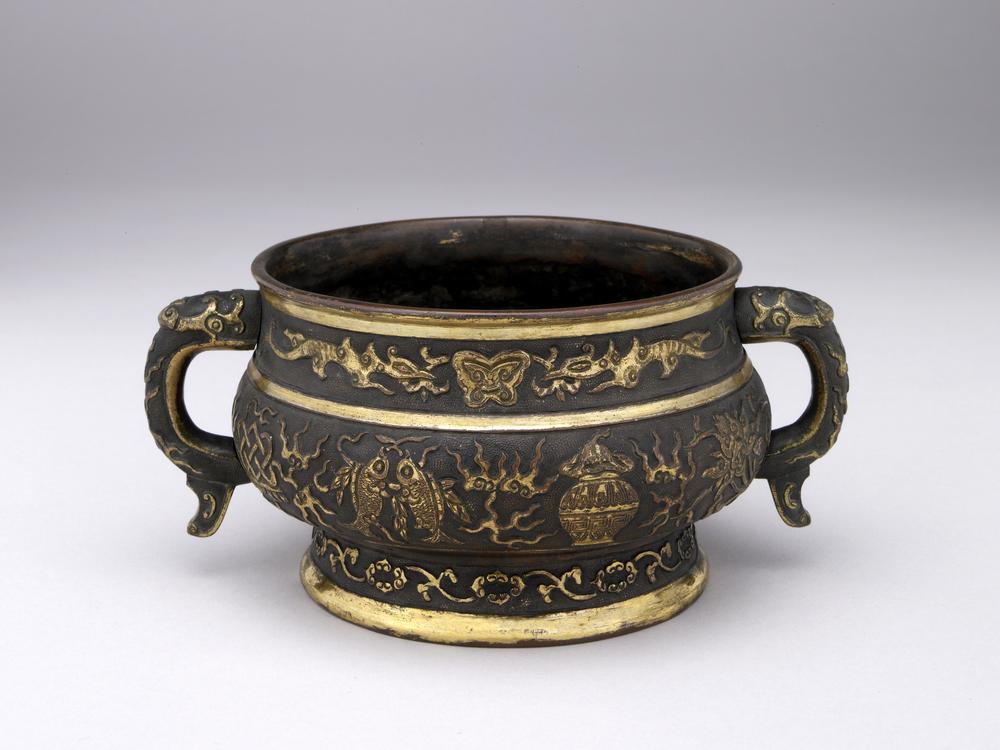Period:Unknown Production date:14thC
Materials:textile
Technique:painted
Subjects:arhat
Dimensions:Height: 57 centimetres Width: 44 centimetres
Description:
A painting on cloth of the arhat Kanakavatsa, barded and haloed, seated; an attendant carrying a bag and an Indian adorant offering coral; in background a waterfall descends beside him, and a large tree fills the space created by the slope of the mountain.
IMG
![图片[1]-painting BM-1955-0416-0.29-China Archive](https://chinaarchive.net/Unknown/Paintings/mid_01508628_001.jpg)
![图片[2]-painting BM-1955-0416-0.29-China Archive](https://chinaarchive.net/Unknown/Paintings/mid_00030940_001.jpg)
![图片[3]-painting BM-1955-0416-0.29-China Archive](https://chinaarchive.net/Unknown/Paintings/mid_00506459_001.jpg)
Comments:Zwalf 1985An Indian tradition greatly developed in Central Asia, Tibet and the Far East was the conception of a number of ‘arhats’ who remained in the world to defend the Doctrine. Among such ‘arhats’ the sixteen with two attendants were very popular in Tibet. Prayers were said to them and they were credited with many miracles.Bearded and haloed, Kanakavatsa sits bent slightly forward, his luminous eyes large and prominent. An attendant carries a bag and an Indian adorant offers coral. In the characteristically Chinese background a mountainous mass of green and blue inclines in the opposite direction to the ‘arhat’’s posture; a waterfall descends beside him, and a large tree fills the space created by the slope of the mountain. Such strongly Chinese forms in a Tibetan painting reflect the intimate relationship created by the conversion of Kublai Khan to Tibetan Buddhism and the political favour extended to the sect he followed.There are many legends about Kanakavatsa whose attribute, a string of precious stones, grants understanding of the Buddhist doctrine. Born in Bihar, he is considered to live in Kashmir with his retinue of 500 ‘arhats’.
Materials:textile
Technique:painted
Subjects:arhat
Dimensions:Height: 57 centimetres Width: 44 centimetres
Description:
A painting on cloth of the arhat Kanakavatsa, barded and haloed, seated; an attendant carrying a bag and an Indian adorant offering coral; in background a waterfall descends beside him, and a large tree fills the space created by the slope of the mountain.
IMG
![图片[1]-painting BM-1955-0416-0.29-China Archive](https://chinaarchive.net/Unknown/Paintings/mid_01508628_001.jpg)
![图片[2]-painting BM-1955-0416-0.29-China Archive](https://chinaarchive.net/Unknown/Paintings/mid_00030940_001.jpg)
![图片[3]-painting BM-1955-0416-0.29-China Archive](https://chinaarchive.net/Unknown/Paintings/mid_00506459_001.jpg)
Comments:Zwalf 1985An Indian tradition greatly developed in Central Asia, Tibet and the Far East was the conception of a number of ‘arhats’ who remained in the world to defend the Doctrine. Among such ‘arhats’ the sixteen with two attendants were very popular in Tibet. Prayers were said to them and they were credited with many miracles.Bearded and haloed, Kanakavatsa sits bent slightly forward, his luminous eyes large and prominent. An attendant carries a bag and an Indian adorant offers coral. In the characteristically Chinese background a mountainous mass of green and blue inclines in the opposite direction to the ‘arhat’’s posture; a waterfall descends beside him, and a large tree fills the space created by the slope of the mountain. Such strongly Chinese forms in a Tibetan painting reflect the intimate relationship created by the conversion of Kublai Khan to Tibetan Buddhism and the political favour extended to the sect he followed.There are many legends about Kanakavatsa whose attribute, a string of precious stones, grants understanding of the Buddhist doctrine. Born in Bihar, he is considered to live in Kashmir with his retinue of 500 ‘arhats’.
© Copyright
The copyright of the article belongs to the author, please keep the original link for reprinting.
THE END
![[Qing Dynasty] British female painter—Elizabeth Keith, using woodblock prints to record China from the late Qing Dynasty to the early Republic of China—1915-China Archive](https://chinaarchive.net/wp-content/uploads/2022/11/image-191x300.png)




